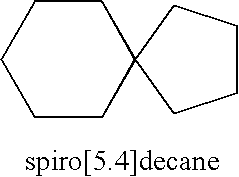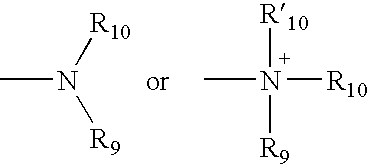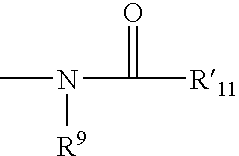Spirocyclic ligands for sigma receptors, and libraries and methods of use thereof
a technology of sigma receptors and ligands, applied in the field of spirocyclic ligands for sigma receptors, and libraries, can solve the problems of limited number of compounds that can be synthesized, limited choice of reagents and conditions that can be employed for the synthesis of non-oligomeric libraries, and desensitization of the receptor or ion channel
- Summary
- Abstract
- Description
- Claims
- Application Information
AI Technical Summary
Problems solved by technology
Method used
Image
Examples
example 1
Synthesis of 3,4-Dihydrospiro[5H-1-benepine-2(1H),4′-piperidin]-5-one (11)
[0329]
1. Synthesis of 1-tert-Butoxycarbonyl-4-allyl-4-(2-bromophenylamino)piperidine (4).
[0330]
[0331]A solution of N-tert-butoxycarbonyl-4-piperidone (1) (18.2 g, 91.4 mmol) and 2-bromoaniline (2) (16.4 g, 95.4 mmol) in anhydrous benzene (24 mL) was heated at reflux, with the azeotropic removal of water. After 3 days, the reaction was allowed to cool to room temperature, and concentrated to obtain 3 as an orange oil.
[0332]To a solution of 3 in anhydrous toluene (200 mL) was added dropwise a solution of allylmagnesium bromide (91 mL, 1 M in diethyl ether, 1 equiv.). After the addition was completed, the reaction was stirred at room temperature for 19 h and was then quenched with sat. aqueous NH4Cl (100 mL). The aqueous layer was extracted with ether (3×200 mL). The combined organic layers were washed with sat. aqueous NaCl and concentrated to yield a crude oil. Silica gel chromatography (95:5 hexanes:EtOAc) aff...
example 2
Synthesis of 1′-(3,4-Dichlorobenzoyl)-3,4-dihydrospiro[5H-1-benzazepine-2(1H)-4′-piperidin]-5-one (12)
[0348]
[0349]To a solution of diamine 11 (20 mg, 0.087 mmol) in anhydrous CH2Cl2 (0.5 mL) was added 3,4-dichlorobenzoyl chloride (22 mg, 0.104 mmol) and piperidinomethyl polystyrene (3.5 mmol / g resin, 25 mg). The reaction mixture was agitated at room temperature for 4 h, and the reaction mixture was then filtered. To the filtrate was added AM resin (3.21 mmol / g resin, 32 mg) and the reaction mixture was agitated for 8 h. The reaction was filtered, and the filtrate was concentrated to yield 12 (15.8 mg, 0.039 mmol, 45%) as a yellow oil. 1H NMR (CDCl3) δ 7.85 (1H, m), 7.50 (1H, m), 7.35 (2H, m), 7.23 (1H, m), 7.01 (1H, m), 6.80 (1H, m), 3.91 (1H, s), 2.85 (6H, m), 2.02 (2H, m), 1.74 (4H, m); LRMS: M+=403.
example 3
Synthesis of 1′-(4-morpholine carbonyl)-3,4-dihydrospiro[5H-1-benzazepine-2(1H)-4′-piperidin]-5-one (13)
[0350]
[0351]To a solution of diamine 11 (10 mg, 0.043 mmol) in anhydrous CH2Cl2 (0.5 mL) was added 4-morpholine carbonyl chloride (8.1 mg, 0.052 mmol) and piperidinomethyl polystyrene (3.5 mmol / g resin, 13 mg). The reaction mixture was agitated at room temperature. for 4 h, and the reaction mixture was then filtered. To the filtrate was added AM resin (3.21 mmol / g resin, 16 mg) and the reaction mixture was agitated for 8 h at room temperature. The reaction was filtered and the filtrate was concentrated to yield 13 (13 mg, 0.038 mmol, 88%) as an oil. LRMS: M+343.
PUM
| Property | Measurement | Unit |
|---|---|---|
| temperature | aaaaa | aaaaa |
| temperature | aaaaa | aaaaa |
| temperature | aaaaa | aaaaa |
Abstract
Description
Claims
Application Information
 Login to View More
Login to View More - R&D
- Intellectual Property
- Life Sciences
- Materials
- Tech Scout
- Unparalleled Data Quality
- Higher Quality Content
- 60% Fewer Hallucinations
Browse by: Latest US Patents, China's latest patents, Technical Efficacy Thesaurus, Application Domain, Technology Topic, Popular Technical Reports.
© 2025 PatSnap. All rights reserved.Legal|Privacy policy|Modern Slavery Act Transparency Statement|Sitemap|About US| Contact US: help@patsnap.com



